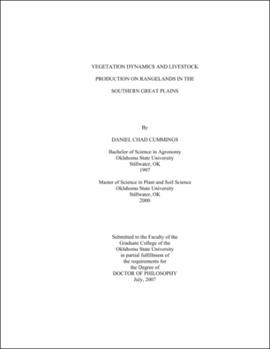| dc.contributor.advisor | Fuhlendorf, Samuel Dean | |
| dc.contributor.author | Cummings, Daniel Chad | |
| dc.date.accessioned | 2013-12-10T18:04:32Z | |
| dc.date.available | 2013-12-10T18:04:32Z | |
| dc.date.issued | 2007-07 | |
| dc.identifier.uri | https://hdl.handle.net/11244/7722 | |
| dc.description.abstract | Scope and Method of Study: We examined vegetation dynamics and livestock production in response to land management practices on rangelands in two different studies, one in north central and one in western Oklahoma. The study in north central Oklahoma tested the effects of altered grazing selectivity of herbivores with patch burning on sericea lespedeza (Lespedeza cuneata) invasion and native plant dynamics compared to traditional rangeland management in the area. The patch-burn study was initiated in 1999 and concluded in 2006. The study in western Oklahoma tested the effects of broad spectrum herbicide application on vegetation dynamics and livestock production in eroded rangelands. This study was initiated in 2000 and concluded in 2006. Both studies were moderately grazed by mixed breed cattle throughout their duration. | |
| dc.description.abstract | Findings and Conclusions: In the north central Oklahoma study, sericea lespedeza invasion rate was four times greater in the traditional management than in the patch-burn study over the seven year study. In addition, vegetative cover of most plant functional groups were negatively correlated with sericea lespedeza cover, though the correlation coefficients were not as high as we had predicted. Herbicide applications to control sericea lespedeza invasions rarely resulted in increased desirable forage production, which commonly serves as the impetus for herbicide application. These results indicate that altering grazing selectivity of large herbivores with patch burning does provide a viable alternative to herbicide applications for the control of sericea lespedeza invasion. Further information about the biology and ecology of this invasive species is also included. In the western Oklahoma study, herbicide applications only resulted in significant reduction of target forbs in one year, and only resulted in increased grass production in one of the six years of the study. There were no significant differences in livestock average daily gain or gain per area between herbicide treatments and the control in any year or over the course of the study. These results indicate that while herbicide applications might be necessary for specific management objectives, they do not result in increased animal production when applied for herbaceous weed control. | |
| dc.format | application/pdf | |
| dc.language | en_US | |
| dc.rights | Copyright is held by the author who has granted the Oklahoma State University Library the non-exclusive right to share this material in its institutional repository. Contact Digital Library Services at lib-dls@okstate.edu or 405-744-9161 for the permission policy on the use, reproduction or distribution of this material. | |
| dc.title | Vegetation dynamics and livestock production on rangelands in the southern Great Plains | |
| dc.contributor.committeeMember | Engle, David M. | |
| dc.contributor.committeeMember | Bidwell, Terrence Guinman | |
| dc.contributor.committeeMember | Lalman, David Leon | |
| osu.filename | Cummings_okstate_0664D_2408 | |
| osu.accesstype | Open Access | |
| dc.type.genre | Dissertation | |
| dc.type.material | Text | |
| dc.subject.keywords | grazing behavior | |
| dc.subject.keywords | invasive plants | |
| dc.subject.keywords | plant dynamics | |
| dc.subject.keywords | community ecology | |
| dc.subject.keywords | herbivory | |
| thesis.degree.discipline | Plant and Soil Sciences | |
| thesis.degree.grantor | Oklahoma State University | |
